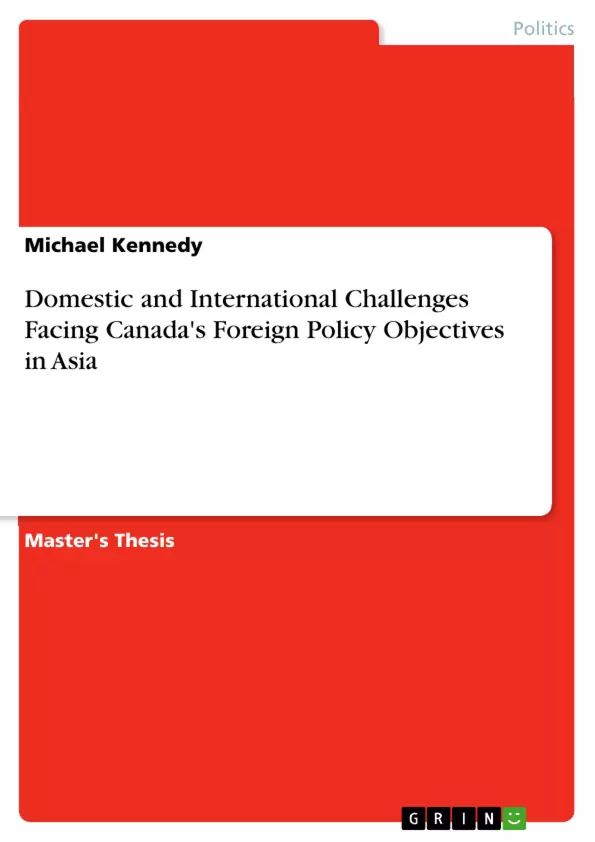This paper discusses Canadian foreign policy within the framework of emerging Asian markets and the diversification of Canadian energy resources. Using Robert Putnam's (1989) two-level game theory, it identifies why Canada has been prompted to shift its focus to Asia and what domestic and international factors challenge Canadian foreign policy goals. This paper discusses these issues in the context of Canada strengthening its relations in the Asia-Pacific in general, as well as its ability to diversify its top export - oil and natural gas - to energy hungry Asian markets.
Inhaltsverzeichnis (Table of Contents)
- INTRODUCTION
- OBJECTIVES
- THESIS STATEMENT
- METHODOLOGY
- LIMITATIONS
- LITERATURE REVIEW
- CANADA'S TRADE DEPENDENCE ON THE UNITED STATES
- CANADA AND THE ASIA-PACIFIC POWER SHIFT
- STATE IDENTITY AND PERCEPTIONS OF CANADA AS A PACIFIC NATION
- NARRATIVE
- THE TRANS-PACIFIC PARTNERSHIP
- LEVEL I: TRANS-PACIFIC PARTNERSHIP MEMBER RESTRICTIONS ON CANADA
- LEVEL II: CANADA'S SUPPLY MANAGEMENT SYSTEM AND INTELLECTUAL PROPERTY RIGHTS STANDARDS
- ASIA-CANADA PERCEPTIONS AND RELATIONS
- LEVEL I: ASIA-PACIFIC PERCEPTIONS OF CANADA
- LEVEL II: CHINESE FOREIGN DIRECT INVESTMENT AND CANADIAN PERCEPTIONS OF ASIA
- U.S. FOREIGN ENERGY DEPENDENCE AND THE DIVERSIFICATION OF CANADIAN OIL
- LEVEL I: U.S. DEPENDENCE ON CANADIAN OIL AND THE KEYSTONE XL PIPELINE
- LEVEL II: SHIPPING ALBERTA'S OIL SANDS RESOURCES TO NON-U.S. MARKETS
Zielsetzung und Themenschwerpunkte (Objectives and Key Themes)
This paper utilizes Robert Putnam's (1989) two-level game theory to explore the factors influencing Canada's foreign policy shift towards Asia-Pacific markets. It examines both domestic and international challenges faced by Canada in pursuing its foreign policy goals, particularly concerning the diversification of its energy exports to Asia. The paper aims to understand why Canada has shifted its focus to Asia and what obstacles hinder its ability to strengthen trade and diplomatic relations in the region.
- The growing economic significance of Asian markets for Canada.
- The role of the Trans-Pacific Partnership in shaping Canada's trade relations with the Asia-Pacific.
- The impact of domestic policies on Canada's ability to pursue its foreign policy objectives.
- The interplay of perceptions and relations between Canada and Asia-Pacific countries.
- The challenges and opportunities associated with diversifying Canadian oil and natural gas exports to Asian markets.
Zusammenfassung der Kapitel (Chapter Summaries)
The paper begins by introducing the historical significance of trade in Canadian foreign policy, highlighting the shift towards Asian markets in recent years. It then delves into the literature review, examining Canada's trade dependence on the United States, the rise of the Asia-Pacific region, and perceptions of Canada's role in the region.
The paper further explores the Trans-Pacific Partnership (TPP) and its impact on Canadian trade relations with the Asia-Pacific. It analyzes the limitations imposed by the TPP and the challenges posed by Canada's domestic policies, such as supply management and intellectual property rights standards.
Moving on to perceptions and relations, the paper examines both Asia-Pacific perspectives on Canada and Canadian perceptions of Asia, focusing on the role of Chinese foreign direct investment. Finally, the paper explores the diversification of Canadian oil and natural gas exports to Asian markets, including the challenges posed by U.S. energy dependence and the Keystone XL pipeline, as well as the potential for shipping Alberta's oil sands resources to non-U.S. markets.
Schlüsselwörter (Keywords)
This research focuses on Canadian foreign policy in Asia-Pacific, two-level game theory, trade diversification, energy exports, Trans-Pacific Partnership, domestic and international challenges, Asia-Pacific perceptions, Chinese foreign direct investment, and the Keystone XL pipeline.
- Quote paper
- Michael Kennedy (Author), 2014, Domestic and International Challenges Facing Canada's Foreign Policy Objectives in Asia, Munich, GRIN Verlag, https://www.grin.com/document/299121



